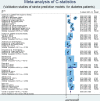Predicting the risk of stroke among patients with type 2 diabetes: a systematic review and meta-analysis of C-statistics
- PMID: 31473609
- PMCID: PMC6719765
- DOI: 10.1136/bmjopen-2018-025579
Predicting the risk of stroke among patients with type 2 diabetes: a systematic review and meta-analysis of C-statistics
Abstract
Objective: Stroke is a major cause of disability and death worldwide. People with diabetes are at a twofold to fivefold increased risk for stroke compared with people without diabetes. This study systematically reviews the literature on available stroke prediction models specifically developed or validated in patients with diabetes and assesses their predictive performance through meta-analysis.
Design: Systematic review and meta-analysis.
Data sources: A detailed search was performed in MEDLINE, PubMed and EMBASE (from inception to 22 April 2019) to identify studies describing stroke prediction models.
Eligibility criteria: All studies that developed stroke prediction models in populations with diabetes were included.
Data extraction and synthesis: Two reviewers independently identified eligible articles and extracted data. Random effects meta-analysis was used to obtain a pooled C-statistic.
Results: Our search retrieved 26 202 relevant papers and finally yielded 38 stroke prediction models, of which 34 were specifically developed for patients with diabetes and 4 were developed in general populations but validated in patients with diabetes. Among the models developed in those with diabetes, 9 reported their outcome as stroke, 23 reported their outcome as composite cardiovascular disease (CVD) where stroke was a component of the outcome and 2 did not report stroke initially as their outcome but later were validated for stroke as the outcome in other studies. C-statistics varied from 0.60 to 0.92 with a median C-statistic of 0.71 (for stroke as the outcome) and 0.70 (for stroke as part of a composite CVD outcome). Seventeen models were externally validated in diabetes populations with a pooled C-statistic of 0.68.
Conclusions: Overall, the performance of these diabetes-specific stroke prediction models was not satisfactory. Research is needed to identify and incorporate new risk factors into the model to improve models' predictive ability and further external validation of the existing models in diverse population to improve generalisability.
Keywords: meta-analysis; prediction model; risk; stroke; systematic review.
© Author(s) (or their employer(s)) 2019. Re-use permitted under CC BY-NC. No commercial re-use. See rights and permissions. Published by BMJ.
Conflict of interest statement
Competing interests: None declared.
Figures




References
-
- WHO The top 10 causes of death. Available: http://www.who.int/mediacentre/factsheets/fs310/en/
-
- Global Health Estimates Geneva: World Health organization, 2012. Available: http://www.who.int/healthinfo/global_burden_disease/en/ [Accessed cited 2017 August 10].
-
- Prevalence of small vessel and large vessel disease in diabetic patients from 14 centres. the world health organisation multinational study of vascular disease in diabetics. diabetes Drafting group. Diabetologia 1985;28(Suppl):615–40. - PubMed
Publication types
MeSH terms
LinkOut - more resources
Full Text Sources
Medical
Miscellaneous
